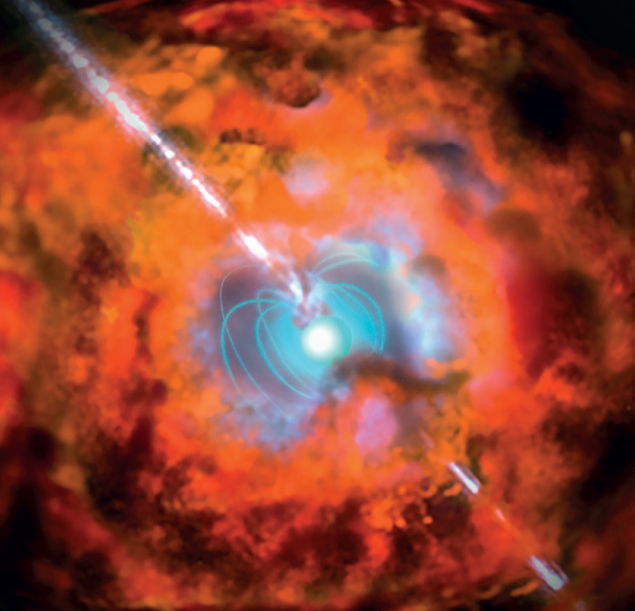
Image credit: ESO.
Based on optical observations, a team of astronomers has, for the first time, demonstrated a link between a very long-lasting gamma-ray burst (GRB) and an unusually bright supernova explosion. The results show that the supernova was not driven by radioactive decay, as expected, but most likely by the spin down of a magnetar, a neutron star with an extremely strong magnetic field.
GRBs have intrigued astronomers since their discovery nearly 50 years ago by US military satellites intended to detect nuclear test explosions conducted by the Soviet Union. Mysterious gamma-ray flashes were detected, not from Earth, but from random directions in the sky. It was only some 30 years later that the detection of their precise locations and the measurement of their redshifts by follow-up observations proved them to be very luminous events from remote galaxies. The further evidence that some of them are associated with supernova explosions settled the issue of their true nature as being a manifestation of the core collapse of a massive star (CERN Courier September 2003 p13).
Astronomers usually distinguish two main classes of GRBs: the short ones that flare up for less than about 2 s and the longer ones. Among the latter, there are a few outstanding bursts lasting more than 10,000 s, which have been proposed to originate in the explosion of giant stars with much larger radii (CERN Courier June 2013 p12). A team led by Jochen Greiner of the Max-Planck-Institut für extraterrestrische Physik in Garching, Germany, has now shown that a supernova explosion is associated with one of these rare ultra-long-duration GRBs, namely GRB 111209A. The supernova’s presence has been derived from observations of the afterglow emission by two telescopes of the European Southern Observatory in Chile: the GROND instrument on the 2.2 m telescope at La Silla and the X-shooter instrument on the Very Large Telescope at Paranal.
The supernova’s spectral and timing properties are both very peculiar. Its luminosity is intermediate between the supernovas usually associated with GRBs and a new class of super-luminous supernovas discovered in 2011. The exceptional luminosity of the latter would be due to energy injection from a rapidly rotating magnetar – a neutron star with a huge magnetic field of up to about 1010 T. The same process could be at play in the supernova of GRB 111209A. Indeed, the huge amount of nickel needed to explain the observed light curve by radioactive decay of 56Ni is not compatible with the rather featureless spectral shape, which suggests a star of low metallicity. While Greiner and colleagues cannot prove that a magnetar is at the origin of the ultra-long GRB of 9 December 2011, nor the source of the luminous and peculiar supernova they observed, they can rule out alternative possibilities, leaving this as the most likely one.
Magnetars have already been invoked to explain the long-lasting afterglow emission of some GRBs (CERN Courier May 2007 p11). Now they seem to be needed to account for powering the prompt emission of some of these powerful flashes of gamma rays. Their advantage is that they would provide a continuous power supply, from hours to months, by losing rotational energy through magnetic-dipole radiation. The flexibility of the magnetar model fits peculiar GRBs and supernovas well, but what about the more standard GRBs? Could they also be powered by a new-born magnetar rather than by a black hole?





